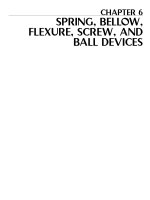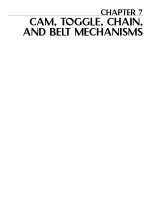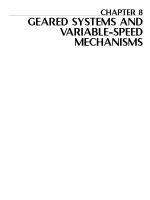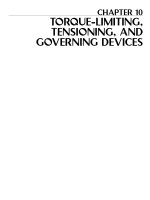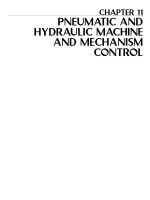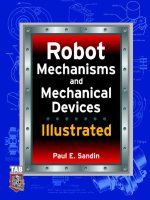Mechanisms and Mechanical Devices Sourcebook - Chapter 10
Bạn đang xem bản rút gọn của tài liệu. Xem và tải ngay bản đầy đủ của tài liệu tại đây (1.49 MB, 29 trang )
CHAPTER 10
TORQUE-LIMITING,
TENSIONING, AND
GOVERNING DEVICES
Sclater Chapter 10 5/3/01 1:07 PM Page 339
340
CALIPER BRAKES
HELP MAINTAIN
PROPER TENSION
IN PRESS FEED
A simple cam-and-linkage arrangement
(drawing) works in a team with two
caliper disk brakes to provide automatic
tension control for paper feeds on a web
press.
In the feed system controlled tension
must be maintained on the paper that’s
being drawn off at 1200 fpm from a roll
up to 42 in. wide and 36 in. in diameter.
Such rolls, when full, weigh 2000 lb. The
press must also be able to make nearly
instantaneous stops.
Friction-disk brakes are subject to lin-
ing wear, but they can make millions of
stops before they need relining.
In the system, two pneumatic disk
brakes made by Tol-O-Matic, Inc.,
Minneapolis, were mounted on each roll,
gripping two separate 12-in. disks that
provide maximum heat dissipation. To
provide the desired constant-drag tension
on the rolls, the brakes are always under
air pressure. A dancer roll riding on the
paper web can, however, override the
brakes at any time. It operates a cam that
adjusts a pressure regulator for control-
ling brake effort.
If the web should break or the paper
run out on the roll, the dancer roll will
allow maximum braking. The press can
be stopped in less than one revolution.
SENSORS AID
CLUTCH/
BRAKES
Two clutch/brake systems, teamed with
magnetic pickup sensors, cut paper
sheets into exact lengths. One magnetic
pickup senses the teeth on a rotating
sprocket. The resulting pulses, which are
related to the paper length, are counted,
and a cutter wheel is actuated by the sec-
ond clutch/brake system. The flywheel
on the second system enhances the cut-
ting force.
This linkage system works in combination with a regulator and caliper disk brakes to stop a
press rapidly from a high speed, if the web should break.
This control system makes cutting sheets to desired lengths and counting how many cuts are
made simpler.
Sclater Chapter 10 5/3/01 1:07 PM Page 340
341
WARNING DEVICE PREVENTS
OVERLOADING OF BOOM
Cranes can now be protected against
unsafe loading by a device whose mov-
able electrical contacts are shifted by a
combination of fluidic power and cam-
and-gear arrangement (see drawing).
The device takes into consideration
the two key factors in the safe loading of
a crane boom: the boom angle (low
angles create a greater overturning
torque than high angles) and the com-
pression load on the boom, which is
greatest at high boom angles. Both fac-
tors are translated into inputs that are
integrated to actuate the electrical warn-
ing system, which alerts the crane opera-
tor that a load is unsafe to lift.
How it works. In a prototype built for
Thew-Lorain Inc. by US Gauge,
Sellersville, Pennsylvania, a tension-to-
pressure transducer (see drawing) senses
the load on the cable and converts it into
a hydraulic pressure that is proportional
to the tension. This pressure is applied to
a Bourdon-tube pressure gage with a
rotating pointer that carries a small per-
manent magnet (see details in drawing).
Two miniature magnetic reed switches
are carried by another arm that moves on
the same center as the pointer.
This arm is positioned by a gear and
rack controlled by a cam, with a sinu-
soidal profile, that is attached to the cab.
As the boom is raised or lowered, the
cam shifts the position of the reed
switches so they will come into close
proximity with the magnet on the pointer
and, sooner or later, make contact. The
timing of this contact depends partly on
the movement of the pointer that carries
the magnet. On an independent path, the
hydraulic pressure representing cable
tension is shifting the pointer to the right
or left on the dial.
When the magnet contacts the reed
switches, the alarm circuit is closed, and
it remains closed during a continuing
pressure increase without retarding the
movement of the point. In the unit built
for Thew-Lorain, the switches were
arranged in two stages: the first to trigger
an amber warning light and second to
light a red bulb and also sound an alarm
bell.
Over-the-side or over-the-rear loading
requires a different setting of the
Bourdon pressure-gage unit than does
over-the-front loading. A cam built into
the cab pivot post actuated a selector
switch.
A cam on the cab positions an arm with reed switches according to boom angle; the pressure
pointer reacts to cable tension.
CONSTANT
WATCH ON
CABLE TENSION
A simple lever system solved the prob-
lem of how to keep track of varying ten-
sion loads on a cable as it is wound on its
drum.
Thomas Grubbs of NASA’s Manned
Spacecraft Center in Houston devised the
system, built around two pulleys
mounted on a pivoted lever. The cable is
passed between the pulleys (drawing) so
an increase in cable tension causes the
lever to pivot. This, in turn, pulls linearly
on a flat metal tongue to which a strain
gage has been cemented. Load on the
lower pulley is proportional to tension on
the cable. The stretching of the strain
gage changes and electrical current that
gives a continuous, direct reading of the
cable tension.
The two pulleys on the pivoting lever
are free to translate on the axes of rota-
tion to allow proper positioning of the
cable as it traverses the take-up drum.
A third pulley might be added to the
two-pulley assembly to give some degree
of adjustment to strain-gage sensitivity.
Located in the plane of the other two pul-
leys, it would be positioned to reduce the
strain on the tongue (for heavy loads) or
increase the strain (for light loads).
A load on the lower pulley varies with ten-
sion on the cable, and the pivoting of the
lever gives a direct reading with a strain
gage.
Sclater Chapter 10 5/3/01 1:07 PM Page 341
342
TORQUE-LIMITERS PROTECT
LIGHT-DUTY DRIVES
Light-duty drives break down when they are overloaded. These eight
devices disconnect them from dangerous torque surges.
Fig. 1 Permanent magnets transmit torque in
accordance with their numbers and size around the cir-
cumference of the clutch plate. Control of the drive in
place is limited to removing magnets to reduce the
drive’s torque capacity.
Fig. 2 Arms hold rollers in the slots that
are cut across the disks mounted on the
ends of butting shafts. Springs keep the
roller in the slots, but excessive torque
forces them out.
Fig. 3 A cone clutch is formed by mating
a taper on the shaft to a beveled central
hole in the gear. Increasing compression on
the spring by tightening the nut increases
the drive’s torque capacity.
Fig. 4 A flexible belt wrapped around
four pins transmits only the lightest loads.
The outer pins are smaller than the inner
pins to ensure contact.
Fig. 5 Springs inside the block grip the
shaft because they are distorted when the
gear is mounted to the box on the shaft.
Sclater Chapter 10 5/3/01 1:07 PM Page 342
LIMITERS PREVENT OVERLOADING
These 13 “safety valves” give way if machinery jams,
thus preventing serious damage.
343
Fig. 6 The ring resists the natural ten-
dency of the rollers to jump out of the
grooves in the reduced end of one shaft.
The slotted end of the hollow shaft acts as
a cage.
Fig. 7 Sliding wedges clamp down on
the flattened end of the shaft. They spread
apart when torque becomes excessive. The
strength of the springs in tension that hold
the wedges together sets the torque limit.
Fig. 8 Friction disks are compressed by
an adjustable spring. Square disks lock into
the square hole in the left shaft, and round
disks lock onto the square rod on the right
shaft.
Fig. 1 A shear pin is a simple and reliable
torque limiter. However, after an overload,
removing the sheared pin stubs and replac-
ing them with a new pin can be time con-
suming. Be sure that spare shear pins are
available in a convenient location.
Fig. 2 Friction clutch torque limiter. Adjustable spring
tension holds the two friction surfaces together to set the
overload limit. As soon as an overload is removed, the
clutch reengages. A drawback to this design is that a slip-
ping clutch can destroy itself if it goes undetected.
Sclater Chapter 10 5/3/01 1:07 PM Page 343
344
Fig. 3 Mechanical keys. A spring holds a ball in a dim-
ple in the opposite face of this torque limiter until an over-
load forces it out. Once a slip begins, clutch face wear
can be rapid. Thus, this limiter is not recommended for
machines where overload is common.
Fig. 4 A cylinder cut at an angle forms a torque limiter. A spring clamps the
opposing-angled cylinder faces together, and they separate from angular align-
ment under overload conditions. The spring tension sets the load limit.
Fig. 5 A retracting key limits the torque in this clutch. The ramped sides
of the keyway force the key outward against an adjustable spring. As the
key moves outward, a rubber pad or another spring forces the key into a
slot in the sheave. This holds the key out of engagement and prevents
wear. To reset the mechanism, the key is pushed out of the slot with a tool
in the reset hole of the sheave.
Fig. 6 Disengaging gears. The axial forces of a
spring and driving arm are in balance in this torque
limiter. An overload condition overcomes the force of
the spring to slide the gears out of engagement.
After the overload condition is removed, the gears
must be held apart to prevent them from being
stripped. With the driver off, the gears can safely be
reset.
Fig. 7 A cammed sleeve connects the input and output shafts of this
torque limiter. A driven pin pushes the sleeve to the right against the
spring. When an overload occurs, the driving pin drops into the slot to
keep the shaft disengaged. The limiter is reset by turning the output shaft
backwards.
Sclater Chapter 10 5/3/01 1:07 PM Page 344
345
Fig. 8 A magnetic fluid is the coupler in this
torque limiter. The case is filled with a mixture
of iron or nickel powder in oil. The magnetic
flux passed through the mixture can be con-
trolled to vary the viscosity of the slurry. The
ability to change viscosity permits the load limit
to be varied over a wide range. Slip rings carry
electric current to the vanes to create the mag-
netic field.
Fig. 9 A fluid is the coupling in this torque
limiter. Internal vanes circulate the fluid in
the case. The viscosity and level of the fluid
can be varied for close control of the maxi-
mum load. The advantages of this coupling
include smooth torque transmission and low
heat rise during slip.
Fig. 10 The shearing of a pin releases
tension in this coupling. A toggle-operated
blade shears a soft pin so that the jaws
open and release an excessive load. In an
alternative design, a spring that keeps the
jaws from spreading replaces the shear pin.
Fig. 11 A spring plunger provides reciprocating motion
in this coupling. Overload can occur only when the rod is
moving to the left. The spring is compressed under an
overload condition.
Fig. 12 Steel shot transmits more torque
in this coupling as input shaft speed is
increased. Centrifugal force compresses
the steel shot against the outer surfaces of
the case, increasing the coupling’s resist-
ance to slip. The addition of more steel shot
also increases the coupling’s resistance to
slip.
Fig. 13 A piezoelectric crystal pro-
duces an electric signal that varies with
pressure in this metal-forming press.
When the amplified output of the
piezoelectric crystal reaches a present
value corresponding to the pressure
limit, the electric clutch disengages. A
yielding ring controls the compression
of the piezoelectric crystal.
Sclater Chapter 10 5/3/01 1:07 PM Page 345
346
SEVEN WAYS TO LIMIT SHAFT ROTATION
Traveling nuts, clutch plates, gear fingers, and pinned members
form the basis of these ingenious mechanisms.
Mechanical stops are often required in automatic machinery and servomechanisms to
limit shaft rotation to a given number of turns. Protection must be provided against
excessive forces caused by abrupt stops and large torque requirements when machine
rotation is reversed after being stopped.
Fig. 1 A traveling nut moves along the threaded shaft until the
frame prevents further rotation. This is a simple device, but the travel-
ing nut can jam so tightly that a large torque is required to move the
shaft from its stopped position. This fault is overcome at the expense
of increased device length by providing a stop pin in the traveling nut.
Fig. 2 The engagement between the pin and the rotating finger
must be shorter than the thread pitch so the pin can clear the finger
on the first reverse-turn. The rubber ring and grommet lessen the
impact and provide a sliding surface. The grommet can be oil-
impregnated metal.
Fig. 3 Clutch plates tighten and stop their rotation
as the rotating shaft moves the nut against the
washer. When rotation is reversed, the clutch plates
can turn with the shaft from A to B. During this
movement, comparatively low torque is required to
free the nut from the clutch plates. Thereafter, sub-
sequent movement is free of clutch friction until the
action is repeated at the other end of the shaft. The
device is recommended for large torques because
the clutch plates absorb energy well.
Sclater Chapter 10 5/3/01 1:07 PM Page 346
347
Fig. 4 A shaft finger on the output shaft hits the
resilient stop after making less than one revolu-
tion. The force on the stop depends upon the gear
ratio. The device is, therefore, limited to low ratios
and few turns, unless a worm-gear setup is used.
Fig. 5 Two fingers butt together at the initial and final positions to prevent rotation
beyond these limits. A rubber shock-mount absorbs the impact load. A gear ratio of
almost 1:1 ensures that the fingers will be out-of-phase with one another until they
meet on the final turn. Example: Gears with 30 to 32 teeth limit shaft rotation to 25
turns. Space is saved here, but these gears are expensive.
Fig. 6 A large gear ratio limits the idler gear to less than one turn.
Stop fingers can be added to the existing gears in a train, making this
design the simplest of all. The input gear, however, is limited to maxi-
mum of about five turns.
Fig. 7 Pinned fingers limit shaft turns to approximately N + 1 revo-
lutions in either direction. Resilient pin-bushings would help reduce
the impact force.
Sclater Chapter 10 5/3/01 1:07 PM Page 347
348
MECHANICAL SYSTEMS FOR CONTROLLING
TENSION AND SPEED
The key to the successful operation of any continuous-processing
system that is linked together by the material being processed is
positive speed synchronization of the individual driving mecha-
nisms. Typical examples of such a system are steel mill strip
lines, textile processing equipment, paper machines, rubber and
plastic processers, and printing presses. In each of these examples,
the material will become wrinkled, marred, stretched or otherwise
damaged if precise control is not maintained.
FIG. 1—PRIMARY INDICATORS
FIG. 2—SECONDARY INDICATORS
FIG. 3—CONTROLLERS AND ACTUATORS
Sclater Chapter 10 5/3/01 1:07 PM Page 348
The automatic control for such a sys-
tem contains three basic elements: The
signal device or indicator, which senses
the error to be corrected; the
controller,
which interprets the indicator signal and
amplifies it, if necessary, to initiate con-
trol action; and the
transmission, which
operates from the controller to change
the speed of the driving mechanism to
correct the error.
Signal indicators for continuous sys-
tems are divided in two general classifi-
cations:
Primary indicators that measure
the change in speed or tension of the
material by direct contact with the mate-
rial; and
secondary indicators that meas-
ure a change in the material from some
reaction in the system that is proportional
to the change.
The primary type is inherently more
accurate because of its direct contact
with the material. These indicators take
the form of contact rolls, floating or com-
pensating rolls, resistance bridges and
flying calipers, as illustrated in Fig. 1. In
each case, any change in the tension,
velocity, or pressure of the material is
indicated directly and immediately by a
displacement or change in position of the
indicator element. The primary indicator,
therefore, shows deviation from an estab-
lished norm, regardless of the factors that
have caused the change.
Secondary indicators, shown in Fig.
2, are used in systems where the material
cannot be in direct contact with the indi-
cator or when the space limitations of a
particular application make their use
undesirable. This type of indicator intro-
duces a basic inaccuracy into the control
system which is the result of measuring
an error in the material from a reaction
that is not exactly proportional to the
error. The control follows the summation
of the errors in the material and the indi-
cator itself.
The controlling devices, which are
operated by the indicators, determine the
degree of speed change required to cor-
rect the error, the rate at which the cor-
rection must be made, and the stopping
point of the control action after the error
has been corrected. The manner in which
the corrective action of the controller is
stopped determines both the accuracy of
the control system and the kind of con-
trol equipment required.
Three general types of control action
are illustrated in Fig. 3. Their selection
for any individual application is based on
the degree of control action required, the
amount of power available for initiating
the control, that is, the torque amplifica-
tion required, and the space limitations of
the equipment.
The on-and-off control with timing
action is the simplest of the three types. It
functions in this way: when the indicator
is displaced, the timer contact energizes
the control in the proper direction for
correcting the error. The control action
continues until the timer stops the action.
After a short interval, the timer again
energizes the control system and, if the
error still exists, control action is contin-
ued in the same direction. Thus, the con-
trol process is a step-by-step response to
make the correction and to stop the oper-
ation of the controller.
The proportioning controller corrects
an error in the system, as shown by the
indicator, by continuously adjusting the
actuator to a speed that is in exact pro-
portion to the displacement of the indica-
tor. The diagram in Fig. 3 shows the pro-
portioning controller in its simplest form
as a direct link connection between the
indicator and the actuating drive.
However, the force amplification
between the indicator and the drive is rel-
349
Sclater Chapter 10 5/3/01 1:07 PM Page 349
